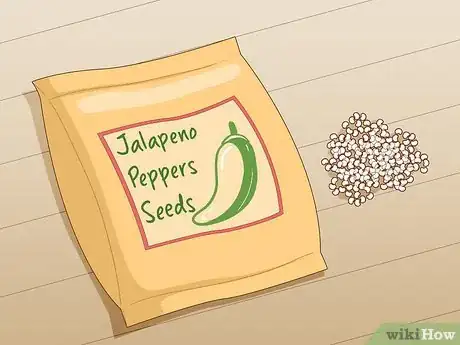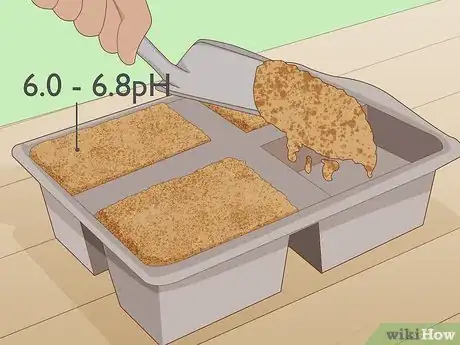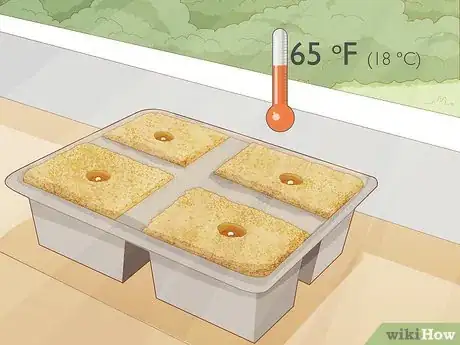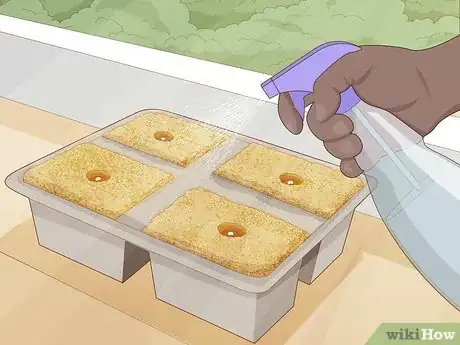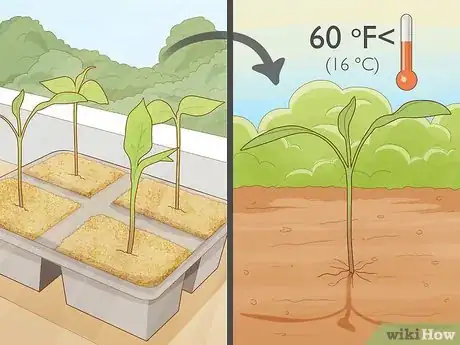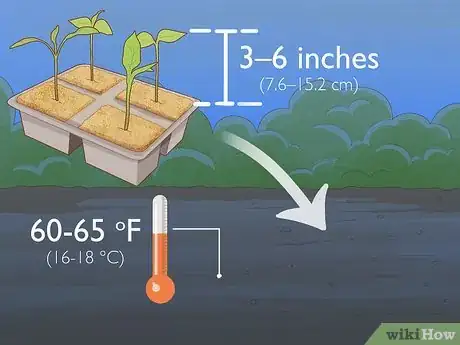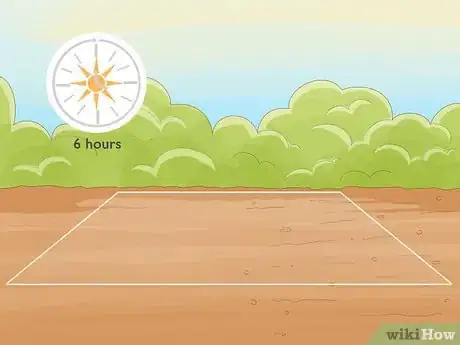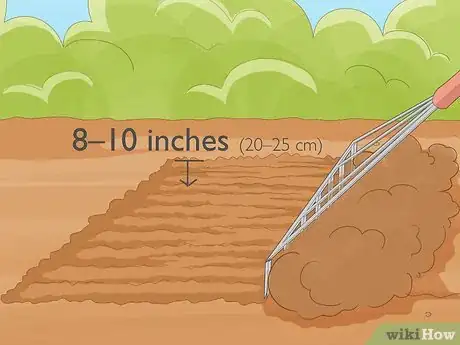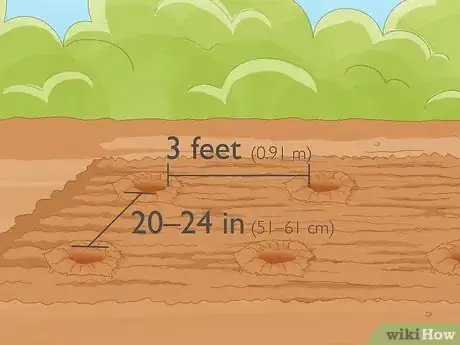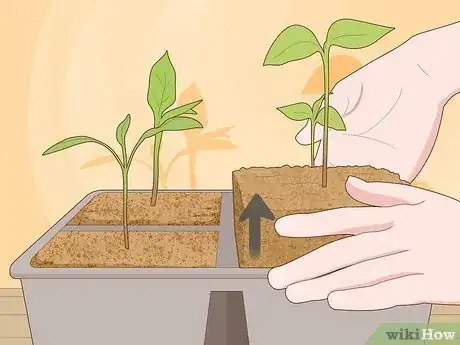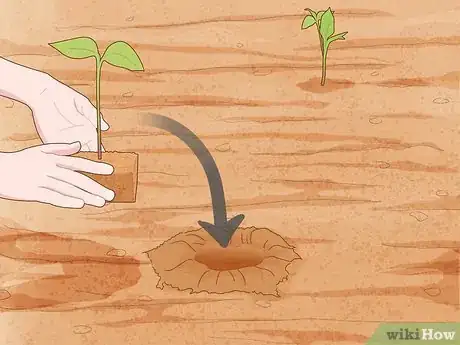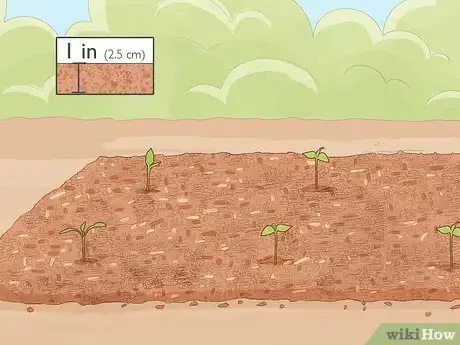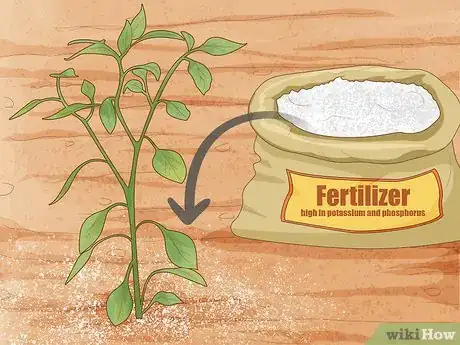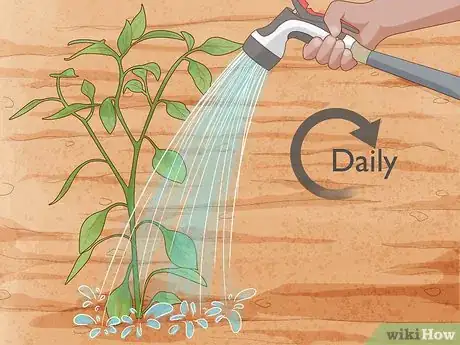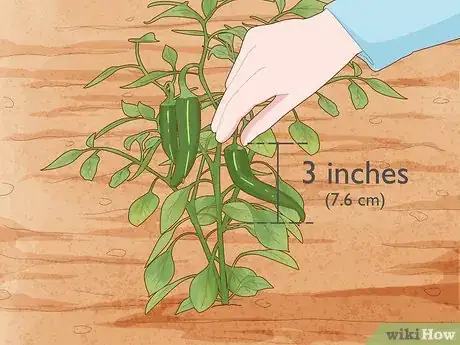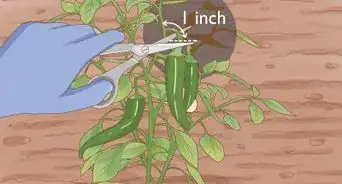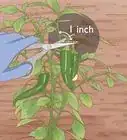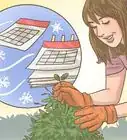This article was co-authored by wikiHow Staff. Our trained team of editors and researchers validate articles for accuracy and comprehensiveness. wikiHow's Content Management Team carefully monitors the work from our editorial staff to ensure that each article is backed by trusted research and meets our high quality standards.
This article has been viewed 245,169 times.
Learn more...
Jalapenos are some of the most popular peppers in the world and are used in a variety of cuisines. If you'd like to enjoy homegrown jalapenos, the process is easy. To grow them from scratch, prep the seeds indoors for 6-8 weeks until the sprout seedlings. You can also buy seedlings from a nursery at the start of the growing season. Then, when the weather gets warm, rake and compost a planting area. Transport your seedlings to this spot and let them grow for 2-3 months. When the peppers are ripe, pick them and enjoy.
Steps
Starting Seeds Indoors
-
1Start growing the seeds indoors 6-8 weeks before the final frost. Starting the seeds this early means they’ll be ready for transplanting outside when the weather warms up. Depending on the area, the final frost may be anywhere from March to May. Check with forecasts in your area to tell when the final frost is expected, and start 6-8 weeks before that to give your seeds enough time to start growing. This means you’ll probably have to start planting around February.[1]
- Starting the seeds indoors is just one option for growing jalapenos. Alternatively, you could buy jalapeno seedlings from a nursery and transplant them into your soil. This avoids the weeks of prep work before the weather gets warm.
-
2Fill small cups or pots with starter soil. Plant each seed in its own cup so the roots don’t get tangled up. Fill each pot to the brim with starter potting soil. Top the soil off and pack it down gently.[2]
- If you’re planting many seeds, planting pods are a good choice to start the seeds in.
- Jalapenos prefer slightly acidic soil with a pH of 6.0-6.8. Test the soil and if the pH is above this level, acidify it with a nitrate fertilizer.
- Remember that each mature plant will produce 30-40 peppers per season. Use this as a judge for how many you should plant.
Advertisement -
3Plant the seeds under 1⁄4 in (0.64 cm) of soil. Pull up a small section of soil in the center of the pot and drop the seed in. Cover it up with a light layer of soil. Remember to plant only one seed in each container.[3]
- Seed packs are available online or from nurseries.
- If you want fresh seeds, harvest them from a fully-grown, red jalapeno. This produces mature, fertile seeds. Cut them open and scrape the seeds out. Remember that jalapenos are spicy, so wear gloves while cutting them. If you get any juice on your hands, wash them thoroughly before touching your face.[4]
-
4Place the pots in a sunny location indoors. Jalapenos need sun and warmth. Place them near a sunny window in direct sunlight.[5]
- To give your seeds extra sunlight, move them to different windows throughout the day as the sun moves across the sky.
- Be sure to keep your indoor temperature over 65 °F (18 °C) so the soil is warm enough for the seeds.
-
5Keep the soil moist with regular watering. Jalapenos need moderate to high watering to thrive. Use a spray bottle and wet the soil as soon as you plant the seeds. Then monitor the soil every day and keep it moist with regular watering.[6]
- Don’t soak the soil. If water pools at the top, you’re using too much water. Try to pour some out to avoid drowning the plant.
-
6Transplant the seedlings outside when the weather is above 60 °F (16 °C). The seedlings need 6-8 weeks to mature. At that point, they're ready to move outside and grow more. Jalapenos like warm soil, so wait until the temperature is consistently above 60 °F (16 °C). In most cases, this will be early spring.[7]
Planting Seedlings Outside
-
1Wait until the weather is above 60 °F (16 °C) to plant seedlings outside. Jalapenos need a soil temperature at least 60–65 °F (16–18 °C) to grow well. Wait until the final frost has passed and the temperature remains above 60 °F (16 °C) even at night.[8]
- If you planted your own seeds inside, the seeds should have sprouted small seedlings after 6-8 weeks. They’ll be 3–6 inches (7.6–15.2 cm) tall by the time you’re ready to transport.
- If you bought seedlings to transplant instead, then plant them when the weather reaches this temperature.
-
2Find a spot that gets at least 6 hours of sunlight every day. Jalapenos like a lot of sunlight, so find the sunniest part of your property. If you aren’t sure which spot is best, monitor your yard for a few days and see which spots get the most direct sunlight for the longest time. Choose this spot for your plants.[9]
-
3Rake and compost the soil 8–10 inches (20–25 cm) deep. Once you choose a planting site, make sure the soil is prepped for the peppers. Take a metal rake and dig up the top 8–10 inches (20–25 cm) of soil. Then pour compost or a similar organic material into the soil to replenish its nutrients. Use the rake to evenly mix the soil and compost together.[10]
- If you have a compost pile on your property, use it for this job.
- If you don’t have a compost pile, use peat moss instead.
-
4Dig holes 20–24 in (51–61 cm) apart in rows spaced 3 feet (0.91 m) apart. The seedlings need enough airflow between them to prevent mold growth and fungus. If you’re planting multiple seedlings, arrange them into straight rows. Dig holes 4 inches (10 cm) deep and 20–24 in (51–61 cm) apart from each other. When you start a new row, move over 3 feet (0.91 m) from the previous row and dig more holes.[11]
- If you’re only planting a few seedlings, then don’t worry about making perfect rows. Just make sure the plants are spaced far enough apart so they don’t grow into each other.
-
5Pull the plants out of the pot, leaving the roots and soil intact. Once you’ve prepped the site, gather the seedlings to transplant. Gently pull each one out of the pot so its roots stay intact. Dig around the plant if you have to and pull the stem and roots up in one piece.[12]
- If you can’t get the plants out easily, then use a small shovel and work around where the soil meets the pot. Try to pull all the soil out.
- If you do damage the plant, transplant it anyway. Plants can be quite resilient and may recover with proper care.
-
6Place a plant in each transplant hole and pack soil around the plant. Take each seedling and place it into a hole with the roots facing down. Then use some potting soil and pack it around the plant so it sits securely. Do this for each seedling you have.[13]
- Don’t bury the stem or leaves of the plant. Only pack soil around its base to cover the roots.
- If the holes are too deep and the whole plant is covered, then fill them with some soil before placing the plant in. Make sure the stem and leaves are above the ground surface.
-
7Spread 1 in (2.5 cm) of mulch to lock water into the soil. Pour out a bag of mulch and spread it around with a rake. Continue working it around until there is an even, 1 inch (2.5 cm) layer around all the plants.[14]
- This step isn’t required, but it’s very helpful to control weeds and make sure your plants get enough water.
- Depending on how many peppers you planted, you may need multiple bags of mulch.
Caring for the Jalapeno Plants
-
1Use a fertilizer high in potassium and phosphorus. These 2 nutrients help the plants produce as many peppers as possible. Go to a garden center and find a fertilizer high in potassium and phosphorus. Apply it as the product directs you to.[15]
- Fertilizers usually instruct you to apply it once a week during the growing season, but follow the directions on the product you use.
- High nitrogen fertilizers won’t kill the plant, but you won’t get as many peppers.
-
2Keep the soil moist with daily watering. Jalapenos require consistent watering, so don't let the soil dry out. Check daily to make sure the soil is moist, and water if it looks dried out. In most climates, you'll have to water the plants every day.[16]
- Try to focus the water at the base of the plants rather than the leaves. Moisture buildup on the leaves can encourage mold growth.
- Also let your plants tell you if they need water. The soil may look moist, but if the plants are wilting, they probably need more water. Increase the amount that you water.
-
3Harvest the peppers when they’re 3 inches (7.6 cm) long. After 60-80 days, the peppers should mature to the point that you can pick them. Go through your plants and pick the green peppers that are about 3 inches (7.6 cm) long. Grab them by the stem and gently twist them off. Then enjoy them in your cooking.[17]
- If you want the peppers to be extra spicy or want to harvest seeds for next year, wait until the seeds turn completely red.
Community Q&A
-
QuestionOther than slugs and other bugs, what else will eat jalapeno peppers?
 Community AnswerBirds can take them, and rats are fans of certain types of peppers.
Community AnswerBirds can take them, and rats are fans of certain types of peppers. -
QuestionWhat can I plant near jalapeno plants?
 Community AnswerMarijuana grows really well with jalapenos. Tomatoes will flourish next to jalapenos.
Community AnswerMarijuana grows really well with jalapenos. Tomatoes will flourish next to jalapenos. -
QuestionIs straw considered a mulch?
 Community AnswerStraw is more of a deterrent for troublesome pests, such as slugs, who enjoy chewing on leaves and possibly flowers.
Community AnswerStraw is more of a deterrent for troublesome pests, such as slugs, who enjoy chewing on leaves and possibly flowers.
References
- ↑ http://www.gardenersnet.com/vegetable/jalapeno-hot-peppers-seeds.htm
- ↑ https://fsi.colostate.edu/jalapeno-peppers/
- ↑ http://www.gardenersnet.com/vegetable/jalapeno-hot-peppers-seeds.htm
- ↑ https://youtu.be/GnfTqF6FIcc
- ↑ http://www.gardenersnet.com/vegetable/jalapeno-hot-peppers-seeds.htm
- ↑ https://fsi.colostate.edu/jalapeno-peppers/
- ↑ https://fsi.colostate.edu/jalapeno-peppers/
- ↑ https://fsi.colostate.edu/jalapeno-peppers/
- ↑ https://agrilifeextension.tamu.edu/library/gardening/peppers/
- ↑ https://agrilifeextension.tamu.edu/library/gardening/peppers/
- ↑ https://agrilifeextension.tamu.edu/library/gardening/peppers/
- ↑ https://agrilifeextension.tamu.edu/library/gardening/peppers/
- ↑ https://agrilifeextension.tamu.edu/library/gardening/peppers/
- ↑ http://www.gardenersnet.com/vegetable/jalapeno-hot-peppers-seeds.htm
- ↑ http://www.gardenersnet.com/vegetable/jalapeno-hot-peppers-seeds.htm
- ↑ https://fsi.colostate.edu/jalapeno-peppers/
- ↑ http://www.gardenersnet.com/vegetable/jalapeno-hot-peppers-seeds.htm
